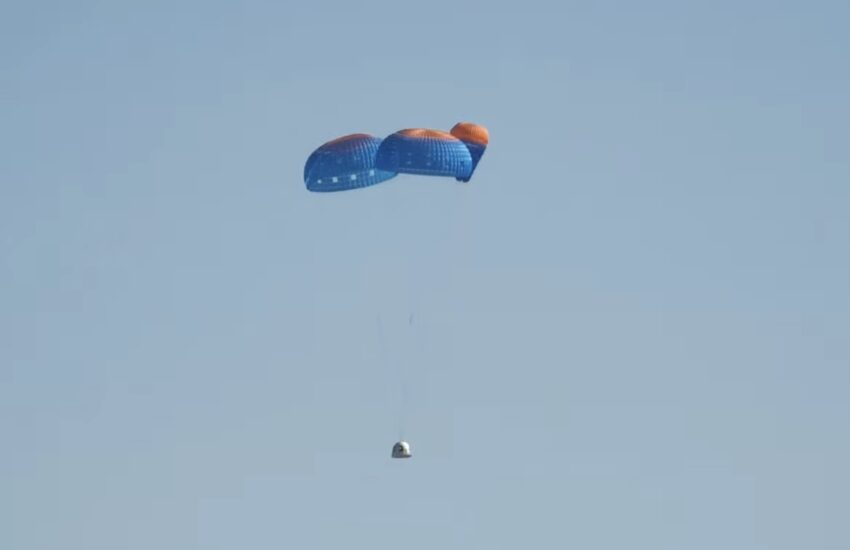KENNEDY SPACE CENTER, Fla. — A parachute failed to fully inflate on the latest Blue Origin New Shepard suborbital flight because a line controlling its expansion was not cut as planned.
One of three parachutes on the crew capsule of New Shepard did not fully inflate during the capsule’s descent on the NS-25 mission May 19. The other two parachutes operated normally and the capsule landed without incident.
During a May 31 briefing about the upcoming Boeing CST-100 Starliner crewed test flight, NASA officials said they had been briefed by Blue Origin about the parachute issue since parachutes on other vehicles, like Starliner, use similar components.
Steve Stich, NASA commercial crew program manager, said the parachutes are designed to open in stages, called reefing, to limit the loads on the parachutes. “In this case, one of the parachutes was stuck in what I would call first stage” of the reefing process, he said, constraining the opening of the parachute.
That is controlled by a band or line at the throat of the parachute. “What was saw was that the cutters, for some reason, did not cut that line,” he said. The parachutes on Starliner use a similar cutter, but Stich said testing showed no evidence of any problems with those used on Starliner. That provided the “flight rationale” for the Starliner launch to proceed.
He praised Blue Origin for sharing information about the parachute issue. “It’s a small group of people who work on these parachutes,” he said, including people at Blue Origin, Boeing, NASA and SpaceX. “They’ve been great at sharing data with us. They don’t really have any kind of root cause yet, and we continue to follow along with them.”
Blue Origin, though, has provided little information to the public about the parachute issue and investigation, not mentioning it in its release about the mission.
“Our New Shepard system uses three parachutes and is designed to land safely with just one deployed,” a company spokesperson told SpaceNews May 31. “We perform thorough post-flight reviews of every flight system, and that analysis continues. We continue to share data and analysis of our parachute deployment with our chute supplier, NASA, and launch providers.”
Parachutes have created problems for several crewed vehicles that use them. Starliner’s crewed test flight was postponed from last year in part to replace parachute components called “soft links” that did not adequate safety margins. SpaceX faced its own challenges with developing parachutes for the Crew Dragon spacecraft and, more recently, noticed that one of four parachutes was slower to open than the others during deployment, but did fully inflate.
The problems with parachutes illustrates the challenges inherent in their design despite decades of experience using them in spaceflight. “It’s the only system you ask to assemble itself in flight,” said Jim McMichael, senior technical integration manager in NASA’s commercial crew program, during an interview before an earlier Starliner launch attempt.
Parachute deployment takes place in a “chaotic environment” affected by factors such as the wake the spacecraft creates behind it in the atmosphere as it descends. “Even today, with all the technology we have and everything else, as far as we’ve come with parachutes, we still can’t model a parachute inflating,” he said. Once it starts to inflate, though, models can accurately predict loads on the system.
“It looks like it should be easy,” he concluded. “It’s still a little bit hard.”

